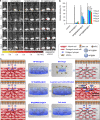A Nano-In-Micro System for Enhanced Stem Cell Therapy of Ischemic Diseases
- PMID: 28852702
- PMCID: PMC5571461
- DOI: 10.1021/acscentsci.7b00213
A Nano-In-Micro System for Enhanced Stem Cell Therapy of Ischemic Diseases
Abstract
Stem cell therapy holds great potential for treating ischemic diseases. However, contemporary methods for local stem cell delivery suffer from poor cell survival/retention after injection. We developed a unique multiscale delivery system by encapsulating therapeutic agent-laden nanoparticles in alginate hydrogel microcapsules and further coentrapping the nano-in-micro capsules with stem cells in collagen hydrogel. The multiscale system exhibits significantly higher mechanical strength and stability than pure collagen hydrogel. Moreover, unlike nanoparticles, the nano-in-micro capsules do not move with surrounding body fluid and are not taken up by the cells. This allows a sustained and localized release of extracellular epidermal growth factor (EGF), a substance that could significantly enhance the proliferation of mesenchymal stem cells while maintaining their multilineage differentiation potential via binding with its receptors on the stem cell surface. As a result, the multiscale system significantly improves the stem cell survival at 8 days after implantation to ∼70% from ∼4-7% for the conventional system with nanoparticle-encapsulated EGF or free EGF in collagen hydrogel. After injecting into the ischemic limbs of mice, stem cells in the multiscale system facilitate tissue regeneration to effectively restore ∼100% blood perfusion in 4 weeks without evident side effects.
Conflict of interest statement
The authors declare no competing financial interest.
Figures





Similar articles
-
A prosurvival and proangiogenic stem cell delivery system to promote ischemic limb regeneration.Acta Biomater. 2016 Feb;31:99-113. doi: 10.1016/j.actbio.2015.12.021. Epub 2015 Dec 12. Acta Biomater. 2016. PMID: 26689466 Free PMC article.
-
Alginate/laponite hydrogel microspheres co-encapsulating dental pulp stem cells and VEGF for endodontic regeneration.Acta Biomater. 2020 Sep 1;113:305-316. doi: 10.1016/j.actbio.2020.07.012. Epub 2020 Jul 11. Acta Biomater. 2020. PMID: 32663663
-
Sustained Release of Immunosuppressant by Nanoparticle-anchoring Hydrogel Scaffold Improved the Survival of Transplanted Stem Cells and Tissue Regeneration.Theranostics. 2018 Jan 1;8(4):878-893. doi: 10.7150/thno.22072. eCollection 2018. Theranostics. 2018. PMID: 29463988 Free PMC article.
-
Sustained release of adipose-derived stem cells by thermosensitive chitosan/gelatin hydrogel for therapeutic angiogenesis.Acta Biomater. 2017 Mar 15;51:258-267. doi: 10.1016/j.actbio.2017.01.060. Epub 2017 Jan 25. Acta Biomater. 2017. PMID: 28131942
-
Acceleration of chondrogenic differentiation of human mesenchymal stem cells by sustained growth factor release in 3D graphene oxide incorporated hydrogels.Acta Biomater. 2020 Mar 15;105:44-55. doi: 10.1016/j.actbio.2020.01.048. Epub 2020 Feb 5. Acta Biomater. 2020. PMID: 32035282
Cited by
-
Stem cells implanted with nanofibrous mats for injured endometrial regeneration and immune-microenvironment remodeling.Mater Today Bio. 2023 Nov 18;23:100855. doi: 10.1016/j.mtbio.2023.100855. eCollection 2023 Dec. Mater Today Bio. 2023. PMID: 38075258 Free PMC article.
-
Advanced Nanotechnology Approaches as Emerging Tools in Cellular-Based Technologies.Adv Exp Med Biol. 2023;1409:127-144. doi: 10.1007/5584_2022_725. Adv Exp Med Biol. 2023. PMID: 35816248 Review.
-
Noncovalent reversible binding-enabled facile fabrication of leak-free PDMS microfluidic devices without plasma treatment for convenient cell loading and retrieval.Bioact Mater. 2022 Mar 16;16:346-358. doi: 10.1016/j.bioactmat.2022.02.031. eCollection 2022 Oct. Bioact Mater. 2022. PMID: 35386332 Free PMC article.
-
Recovery of Ischemic Limb and Femoral Artery Endothelial Function Are Preserved in Mice with Dextran Sodium Sulfate-Induced Chronic Colitis.Biology (Basel). 2022 Aug 4;11(8):1169. doi: 10.3390/biology11081169. Biology (Basel). 2022. PMID: 36009796 Free PMC article.
-
Bioinspired 3D Culture in Nanoliter Hyaluronic Acid-Rich Core-Shell Hydrogel Microcapsules Isolates Highly Pluripotent Human iPSCs.Small. 2021 Aug;17(33):e2102219. doi: 10.1002/smll.202102219. Epub 2021 Jul 14. Small. 2021. PMID: 34260817 Free PMC article.
References
-
- Luttun A.; Tjwa M.; Moons L.; Wu Y.; Angelillo-Scherrer A.; Liao F.; Nagy J. A.; Hooper A.; Priller J.; De Klerck B. Revascularization of Ischemic Tissues by Plgf Treatment, and Inhibition of Tumor Angiogenesis, Arthritis and Atherosclerosis by Anti-Flt1. Nat. Med. 2002, 8, 831–840. - PubMed
-
- Zhao S.; Xu Z.; Wang H.; Reese B. F.; Gushchina L.; Jiang M.; Agarwal P.; Xu J.; Zhang M.; Shen R.; Liu Z.; Weisleder N.; He X. Bioengineering of Injectable Encapsulated Aggregates of Pluripotent Stem Cells for Therapy of Myocardial Infarction. Nat. Commun. 2016, 7, 13306.10.1038/ncomms13306. - DOI - PMC - PubMed
Grants and funding
LinkOut - more resources
Full Text Sources
Other Literature Sources
Research Materials

